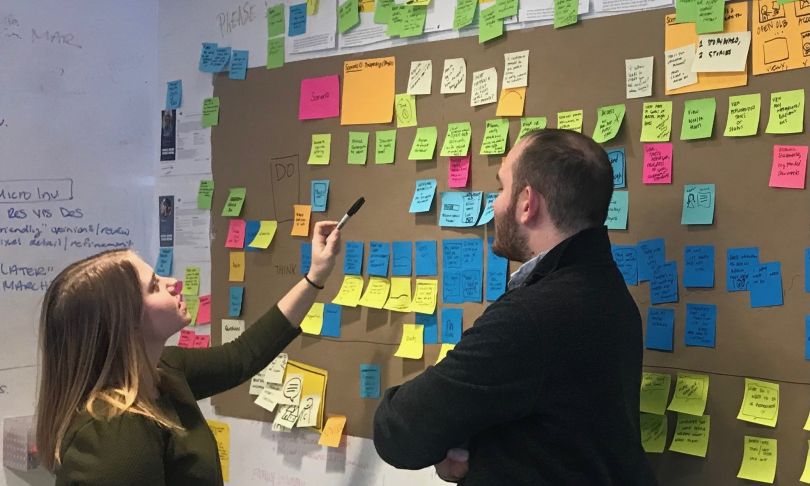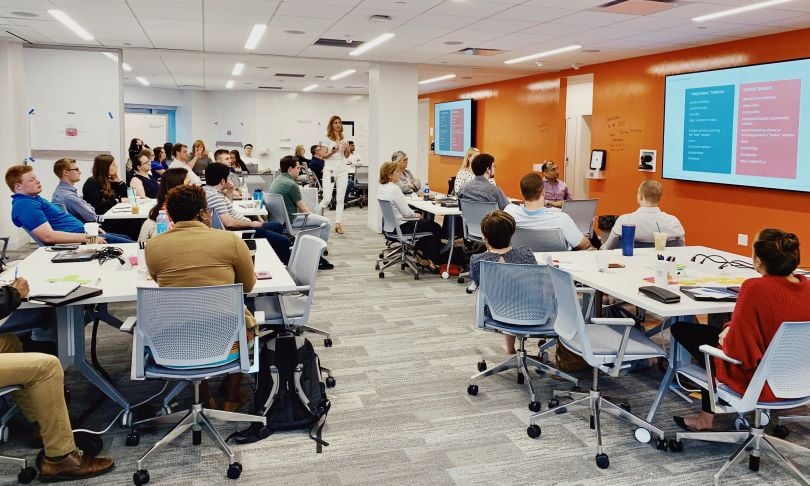For Alyssa Ilov, PNC’s innovation director, activating design thinking across PNC is as much about transforming the way the product and technology teams solve problems as it is about developing game-changing experiences.
“When our partners come to us for help, we ask, ‘What’s the problem you’re trying to solve? What’s the impact you’re trying to create and for whom?’” she said. “Ultimately, our goal is to deliver insights and solutions that help drive better outcomes for our clients, as well as our employees.”
Ilov leads the Experience Innovation team, which serves as PNC’s internal design-thinking arm. Her team is responsible for building creative solutions to complex issues by envisioning the future and understanding the needs and desired outcomes of its partners.
Ilov’s team brings a tailored, customer-first approach that not only delivers significant value but has caused a notable cultural shift across the company.
Over the nine years Ilov has worked at PNC, she’s seen departments across the bank embrace design-thinking concepts by evaluating impact on customers from different perspectives. Even more, she has seen this shift across teams that hadn’t traditionally viewed themselves as “customer facing.” Successful application of this type of thinking helped design teams create digital, self-service capabilities for PNC credit cards and also helped developers enhance the customer experience in cases where a credit card is lost or stolen.
Ilov compares this gradual shift to steering a large ship: “You may not even notice it’s happening, yet over time, the horizon changes,” she said.
The team balances teaching with doing. While similar groups at other organizations often focus on one or the other, the Experience Innovation team intentionally does both. In addition to helping partners across the bank solve problems, the team trains other employees to apply design-thinking methods and mindsets in their own roles. This approach helps PNC employees recognize design thinking’s value and impact firsthand and positions them to apply this approach on their own.
WHAT IS DESIGN THINKING?
According to Ilov, design thinking is a framework that enables teams to put the user at the center of any problem by surfacing the user’s needs, motivations and behaviors, and creating a solution to address them.
The framework is broken into three segments: desirability, feasibility and viability. Teams consider why a user wants something, whether that want can actually be delivered, and if that want has a positive impact on the business. “When these three things — desirability, feasibility and viability — come together, you deliver design-driven innovation,” Ilov said.

Designing Influence
When Ilov walked through PNC’s doors on her first day at the bank, she noticed one thing in particular — an unwavering commitment to the customer.
“The executive team supported design thinking and its ability to help us understand and deliver for our customers,” Ilov said. “This level of support isn’t always common at other companies, where design leaders often fight for a seat at the table.”
Ilov’s experience at PNC has been the exact opposite. Over the past few years, her team has been engaged in highly visible projects to redesign products and experiences, including Low Cash Mode.
Low Cash Mode is a digital offering that helps PNC’s Virtual Wallet customers avoid overdraft fees through unprecedented account transparency and control. This solution has had a transformative effect on the industry’s approach to overdraft fees and demonstrates the potential for design thinking to help drive real, widespread change.
To succeed in developing successful solutions, such as this one, Ilov’s team delivers experiences to customers early and often. By introducing customers to prototypes of a solution or feature, Ilov’s team is able to fine tune the solution and optimize its impact on the customer’s experience.
“To succeed in developing successful solutions, such as Low Cash Mode, Ilov’s team delivers experiences to customers early and often, fine tuning the solution and optimizing its impact.”
Before developing solutions and features, Ilov’s team leverages ethnographic and user experience research approaches to deliver personas, insights and design principles that ultimately drive product and design decisions. For example, the team researched consumers’ perspectives on financial wellness and data security to help inform two projects that will ultimately help PNC better support its customers.

‘The Right People’
Ilov has built up her team intentionally, ensuring she has “the right people to deliver the right work.” By “right people,” she means employees with a wide range of professional backgrounds and an inherently inquisitive nature.
According to Ilov, there’s no single skill or academic qualification that defines design thinking professionals. Some of the employees on her team are engineers, anthropologists and even interior designers.
“I look for diverse skill sets and for people who can view a problem from every angle, dissect it and bring all of those perspectives together to understand the user and develop the right solution,” Ilov said.
“I look for diverse skill sets and for people who can view a problem from every angle, dissect it and bring all of those perspectives together to understand the user and develop the right solution.”
To determine which individuals possess the right skills, Ilov has prospective employees participate in a design challenge. While the design is important, she’s more interested in the process someone uses to get there.
“We are looking for candidates with strong critical thinking and collaboration skills. We focus on their approach and pay attention to the questions they ask. In general, how they unpack the problem and understand the users,” Ilov said.
In gauging candidates’ collaboration and problem-solving skills, Ilov prefers to lead from behind and allow her team members to take center stage.
“A lot of times, when I’m in meetings or even final presentations, I’m not doing much of the talking, if any at all,” she said. “I’m giving my people opportunities and setting them up for success.”
Being a member of the experience innovation team at PNC means having the chance to deliver exceptional designs — and own the impact.






